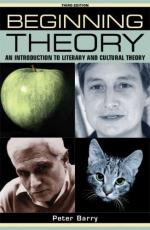
|
| Name: _________________________ | Period: ___________________ |
This test consists of 15 multiple choice questions and 5 short answer questions.
Multiple Choice Questions
1. The narrator explains in the Introduction that the emphasis on practice means that this is what form of book?
(a) Missal.
(b) Manuscript.
(c) E-book.
(d) Work book.
2. Whom does Peter Barry credit for being the first person and anthropologist to use structuralism in their work?
(a) Alfred Tennyson.
(b) F. Scott Fitzgerald.
(c) Claude Levi-Strauss.
(d) W.B. Yeats.
3. Who was the first critic to develop a "reader-centered" approach to literature?
(a) Sigmund Freud.
(b) Plato.
(c) Aristotle.
(d) Sophocles.
4. Who said the following quote found in the chapter titled Theory Before Theory--Liberal Humanism: "We are told that the study of literature 'cultivates the taste, educates the sympathies and enlarges the mind'"?
(a) Elie Wiesel.
(b) Edward Freeman.
(c) Oscar Wilde.
(d) Lewis Carroll.
5. The narrator reveals that the modern period began with the ________.
(a) Innocence.
(b) Enlightenment.
(c) Reason.
(d) Mythology.
6. ________ was probably the most influential figure in twentieth-century British criticism according to author Peter Barry.
(a) Douglas Adams.
(b) Patrick Tilley.
(c) Edward Jablonski.
(d) F.R. Leavis.
7. Who was appointed Professor at King's College, London in 1840?
(a) Frank McCourt.
(b) Nick Hornby.
(c) J.R.R. Tolkien.
(d) F.D. Maurice.
8. All of the following religious believers were not allowed to attend university in England in the nineteenth century except which one?
(a) Catholic.
(b) Jewish.
(c) Anglican.
(d) Atheist.
9. Author Peter Barry informs the reader that the feminist literary criticism of today was the direct product of the "women's movement" of the ________.
(a) 1980s.
(b) 1960s.
(c) 1910s.
(d) 1930s.
10. The Introduction states that another name for traditional literary criticism is ________.
(a) Independant humanism.
(b) Conservative humanism.
(c) Modern humanism.
(d) Liberal humanism.
11. In what decade did "postmodernism" become current according to the author?
(a) 1980s.
(b) 1950s.
(c) 1990s.
(d) 1910s.
12. Sigmund Freud believed that a ________ was an escape-hatch or safety-valve through which repressed desires, fears, or memories seek an outlet into the conscious mind.
(a) Dream.
(b) Poem.
(c) Memoir.
(d) Fetish.
13. Who presented I.A. Richard with the manuscript of the book which was published in 1930 with the title Seven Types of Ambiguity?
(a) Wilfred Owen.
(b) Kurt Vonnegut.
(c) William Empson.
(d) George Zebrowski.
14. David Lodge, Professor of English at Birmingham, combined the ideas of structuralism with more traditional approaches in which one of his books?
(a) Working with Structuralism.
(b) Beginning Structuralism.
(c) Transforming Structuralism.
(d) Beyond Structuralism.
15. According to the chapter titled Structuralism, what is another term for "alba," the poetic form dating from the twelfth century in which lovers lament the approach of daybreak?
(a) Dawn song.
(b) Breaking dawn.
(c) Morning glory.
(d) Morning love.
Short Answer Questions
1. The chapter titled "Postmodernism" states the term "postmodernism" was used in the 1930s, but its current sense and vogue can be said to have begun with ________'s "The Postmodern Condition: A Report on Knowledge."
2. Jean Baudrillard was associated with what is usually known as ________ according to the narrator.
3. According to Peter Barry, where does post-structuralism ultimately derive from?
4. Which of the following term best can be defined as one in which we cannot know where we are, since all the concepts which previously defined the center, and hence also the margins, have been "deconstructed," or undermined?
5. The chapter "Postmodernism" details that Ezra Pound calls his major work, "The Cantos" a ________.
|
This section contains 534 words (approx. 2 pages at 300 words per page) |

|




